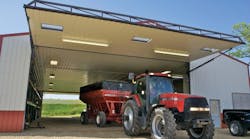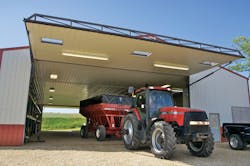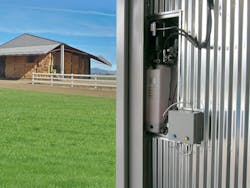Airplane hangars need tall, wide openings to make it easy to move aircraft in and out. The same goes for service garages for large boats and mining, construction, and agricultural equipment. In most cases, these large openings need doors for security and to isolate a building’s interior from the surrounding environment. Scaled-up versions of residential garage doors generally are not practical. In fact, electromechanical door openers contain multiple parts that require periodic lubrication, and tracks, motors, bearings, and drives. Moreover, they can obstruct openings, which not only imposes on interior space of the building, but leaves the mechanisms susceptible to damage if equipment wanders from its intended course and impacts the mechanism.
Hydroswing North America avoids the disadvantages of mechanical mechanisms with its swing-out doors that use a pair of hydraulic cylinders for opening and closing. These doors can be as tall as 40 ft. and up to 150 ft. wide. The swing-out mechanism takes up little space, and the single-piece door is sturdy and can easily be insulated. When in the raised position, it also provides a canopy in front of a building entrance to provide shelter form sun and rain. The doors are also rugged, exhibited by their ability to withstand winds to 200 mph while closed and 100 mph while open, depending on the specific design of the door.
Probably the biggest advantage of Hydroswing doors over other designs is their use of compact hydraulics. A hydraulic power unit, consisting of pump, reservoir, valves, filters, and other components, is normally wall-mounted near the door. However, the HPU can be mounted where most convenient — even in an adjacent room when special conditions prevail. This remote mounting of the HPU can eliminate the need for using an explosion-proof motor. Two hydraulic lines route fluid from the HPU to a pair of double-acting hydraulic cylinders, which provide the smooth, controlled linear motion and high force needed to actuate the door. The HPU is sized according to the maximum pressure and flow required to lift the door. Depending on size and weight of the door, lifting and closing cycles range from about 45 to 90 sec. Once closed, the hydraulic cylinders lock in position, so the door cannot be opened unless the HPU is activated.
Hydroswing doors are used as an alternative to bottom-rolling, accordion, fabric, and sliding doors, which typically contain many moving parts and often require increased maintenance over time. Some applications, however, cannot accommodate the single-piece, swing-out door. To address these situations, Hydroswing recently introduced a dual-panel door, which requires half the swing out distance in front of the door of the single-panel door. The dual-panel doors use a shorter pair of hydraulic cylinders that actuate only the top panel of the door. The bottom panel is hinged to the top panel and slides along the frame so that the door folds in half as it’s lifted by the cylinders. As with single-panel doors, the dual-panel doors are pre-hung on their own frame for easy installation.
For more information, call Hydroswing North America, Inc., Carlsbad, Calif., at (800) 404-4937, or visit www.hydroswing.com.



